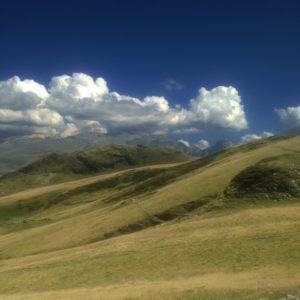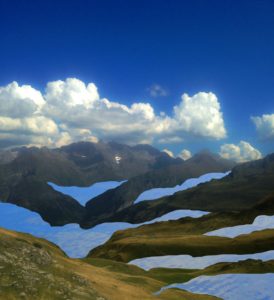All posts by Juliette Cullinane
Filters
Evaluation
Comparison of my work to artists work.
These are three of my final images compared to three images by Richard Billingham, overall I think you can see the influence of Richard Billingham's work in my images, I have tried take influence from his style by capturing conventional moments of people in their natural environments getting on with their everyday lives, trying to give a sense that you are not looking at an image but are just another person in the room that they don't notice.The main focus of my images was to document and capture the life of my grandmother who has Alzheimer's, my intention was to try and capture candid moments of their everyday life, by capturing the constant surprised and dazed look of my grandmother and them going about their everyday life. I wanted to be able to follow the idea of Conventions and groups of people and by taking photos of my own family I think that I have captured a different and more personal perspective than if I had documented strangers. I tried to make sure that the composition of each photo reflected the closeness of the topic and how it was from a personal perspective rather than an outsider, as part of the composition of the images I wanted the people to be the main subject but also have their everyday surroundings which are a big part of their lives also be a focus of the images. As I wanted the images to be a reflection of the people and their lives I tried to keep the lighting quite dull and the colours neutral to reflect the emotions and slow energy of their lives.
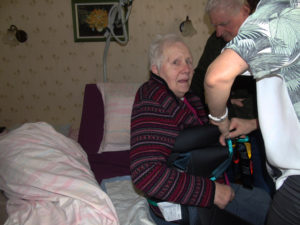

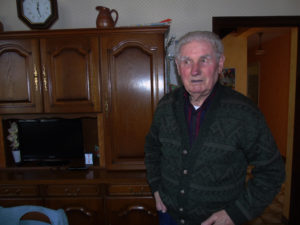
Images by Richard Billingham

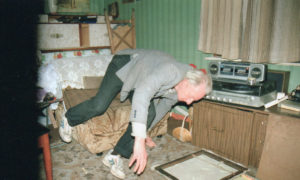
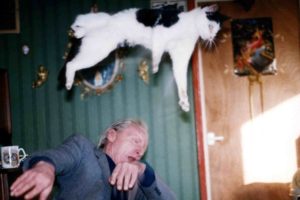
Final selection of images and presentation
For my final presentation of my images I have decided to make a selection of nine of my strongest images and present them in a window mount, i have selected the nine images that I think best represent my intention of showing the candid moments and emotions, I decided to present them in a 3x3 black window mount because I think that photos show more when they are together rather than being presented as single images.
These are the nine images that I selected to present.


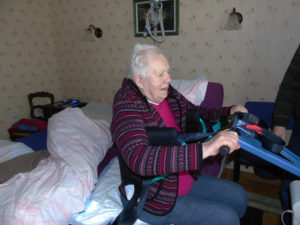

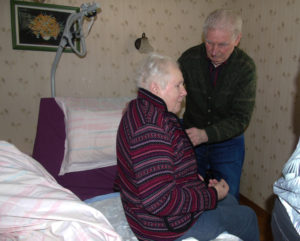

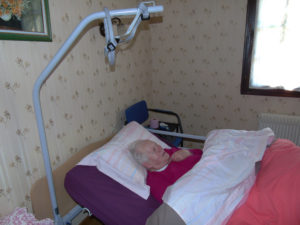


Before attaching the photos to the mount I tried out a few different arrangements to see which would look best. I tried to find a layout which made each photo stand out and so that there was a variation of compositions and colours in each row/column to make it more aesthetically pleasing to look at.
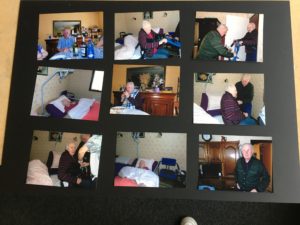
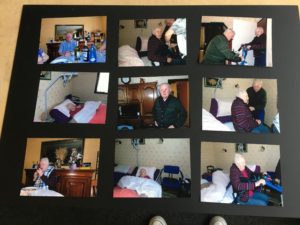


This is my final arrangement attached to the window mount. I feel that this was the best layout because there is a variety in each row and i tried to make sure that similar compositions would not be to close together even though all the photos are quite similar there is some variety so i tried to lay it out so that there was variation of lighting and composition.
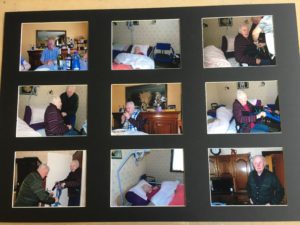
Richard Billingham response
My response to Richard Billingham
In response to Richard Billingham I decided to document my grandparents, the main focus being my grandmother who has Alzheimer's, I wanted to show the difficulties for someone who has Alzheimer's and also the effect it has on the people around them, in this case my grandfather who looks after her. My intention was to try and capture candid moments of their everyday life to show how Alzheimer's takes away memory of people and places, by capturing the constant surprised and dazed look of my grandmother who can see me taking her photo but does no necessarily know who i am or what i'm really doing, but also everyday functions such as eating, speaking and walking, as you can see in the photos she spends most of her day lying in bed because she simply doesn't know how to do anything else anymore.
These are a few of the images that I selected from my shoot as i think they best represent my intention.
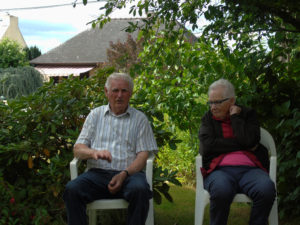







Photoshoot



Richard Billingham
Richard Billingham is an English photographer, his work has mostly concerned his family. He came to prominence through his candid photography of his family in Cradley Heath, a body of work later added to and published in the acclaimed book Ray's A Laugh (1996). Ray's a Laugh is a portrayal of the poverty and deprivation in which he grew up. Billingham chose to use the cheapest film and development he could find. Ray, his father, and his mother Liz, appear at first glance as grotesque figures, with the alcoholic father drunk on his home brew, and the mother, an obese chain smoker with an apparent fascination for nicknacks and jigsaw puzzles. However, there is such integrity in this work that Ray and Liz ultimately shine through as troubled yet deeply human and touching personalities.






"The pictures shown here are of my father Raymond (born 1931): my mother Elisabeth (born 1950) and my brother Jason (born 1977). Ray is a chronic alcoholic and has drunk for as long as I can remember. He has not worked since he was mode redundant from his job as a machinist around 1980. Liz very rarely drinks but she does smoke a lot of cigarettes. My younger brother still does not seem to know what he wants: he gets a job for or week or two and then leaves it. I think he is very lazy. I started using a camera about six years ago. I felt I needed some kind of reference material for my paintings as it is quite difficult to get people to give their time to pose for you. I was still living with my dad at the time. Ray stopped in his room almost constantly drinking and sleeping. If he went outside he become ill. He drank to get to sleep. He had a friend from a neighbouring towerblock -himself an alcoholic - who came around to make strong home-brew for him. This was much cheaper than 'buying' alcohol and meant that Ray didn't have to venture outside to the off-licence. He kept the home-brew bucket by the side of his bed for convenience and drank from a plastic jug that he would dip into the brew. It tasted as bad as it looked but it must hove nourished him somehow because he otherwise never ate. Liz wasn't living with us then: she had left due to Roy's incessant drinking and moaning. She seldom visited. This was all quite sad and I wanted to make paintings about it that were very moving: that would express the tragedy of it all. When I printed up those photographs (I worked in black-and-white then because it was cheaper than colour) I was apprehensive about letting on to anybody about who they were of for fear of becoming unpopular with the other students who were, I believe, all from much more financially and spiritually secure family backgrounds. I was fairly introvert as a teenager because I had always been somewhat embarrassed about the state of my family. Yet after a few months at college I realised that by letting students and, especially, tutors know who the paintings and photographs were really of I could come clean about the family history and hence relate to people naturally. This was quite a load off me and since then I think l've been taking pictures of my close family not just as reference for paintings but also as on attempt to comprehend myself and them more fully. I have done very little painting since graduating partly because of a lack of funds for studio space and partly because I has a supermarket job stacking shelves. Instead, I worked on the book 'Ray's a Laugh’ which was published in April. My parents and brother are very happy with the book. Neither I nor they ore shocked by its directness because we're all well-enough acquainted with having to live with poverty. After all, there are millions of other people in Britain living similarly… It is certainly not my intention to shock, to offend, sensationalise, be political or whatever. Only to make work that is as spiritually meaningful as I can make it. Whatever the medium.”
Richard Billingham, May 1996
http://www.saatchigallery.com/artists/richard_billingham.htm
Martin Parr
Martin Parr is a British documentary photographer and photojournalist. He is known for his photographic projects that take an intimate, satirical and anthropological look at aspects of modern life, in particular documenting the social classes of England, and more broadly the wealth of the Western world. Parr has said of his photography: 'The fundamental thing I'm exploring constantly is the difference between the mythology of the place and the reality of it. ...Remember I make serious photographs disguised as entertainment. That's part of my mantra. I make the pictures acceptable in order to find the audience but deep down there is actually a lot going on that's not sharply written in your face. If you want to read it you can read it.' Parr's aesthetic is close-up, through use of a macro lens, and employing saturated colour, a result of either the type of film and/or use of a ring flash. This allows him to put his subjects "under the microscope" in their own environment, giving them space to expose their lives and values in ways that often involve inadvertent humour. His technique, as seen in his book Signs of the Times: A Portrait of the Nation's Tastes (1992), has been said to leave viewers with ambiguous emotional reactions, unsure whether to laugh or cry. At first glance, his photographs seem exaggerated or even grotesque. The motifs he chooses are strange, the colours are garish and the perspectives are unusual. Parr’s term for the overwhelming power of published images is “propaganda”. He counters this propaganda with his own chosen weapons: criticism, seduction and humour. As a result, his photographs are original and entertaining, accessible and understandable. But at the same time they show us in a penetrating way how we live, how we present ourselves to others, and what we value.
Images by Martin Parr

Meshes of the Afternoon (1943)
Meshes of the Afternoon (1943) is a short experimental film directed by wife-and-husband team Maya Deren and Alexander Hammid. The film's narrative is circular and repeats several motifs, including a flower on a long driveway, a key falling, a door unlocked, a knife in a loaf of bread, a mysterious Grim Reaper–like cloaked figure with a mirror for a face, a phone off the hook and an ocean. Through creative editing, distinct camera angles, and slow motion, the surrealist film depicts a world in which it is more and more difficult to catch reality. The film was the product of Deren's and Hammid's desire to create an avant garde personal film that dealt with devastating psychological problems, like the French surrealist films of the 1920s such as Salvador Dalí and Luis Buñuel's Un Chien Andalou (1929) and L'Age d'Or (1930).
![]()
Secrets, Codes and Conventions
Secret = something that is kept unknown or unseen by others/ something that is not properly understood (a mystery). Code = a system of words, letters, figures or symbols used to represent others, especially for the purpose of secrecy. Conventions = a way in which something is usually done. The group photo has powerful underlying conventions, whether a family portrait or of a gathering of friends. These reflect codes of behavior that shift over time. In the early 1990s Paul M Smith explored the convention of the ‘team photo’ and the ‘night out’ – photographs so often taken by groups of ‘lads’, which he took to be anything but spontaneous. Trish Morrissey gently subverted the ritual of the family holiday photo in her 2005-7 series of photographs called Front, often swapping clothes and taking on the role of the mother in semi- formal gatherings staged on beaches in Britain and Australia.
MOODBOARD OF IDEAS

Joan Fontcuberta
One of Spain's most prominent and innovative artists, Joan Fontcuberta is best known for exploring the interstices between art, science, and illusion. Where science reaches its limits in his works, the imagination frequently finds a creative space in which to flourish. In Landscapes without Memory, Fontcuberta has co-opted a piece of computer software originally designed for military or scientific use in rendering three-dimensional images of landscapes. The software enables the user to build photo-realistic models based on information scanned from two-dimensional sources—usually satellite surveys or cartographic data. The result gives the user the illusion of navigating in three dimensions which had previously been visualized only as a flat image.Fontcuberta feeds the software fragments of pictures by Turner, Cézanne, Dalí, Stieglitz, Weston, and others, forcing the program to interpret a variety of landscape masterworks as "real." The contours and tones of these painted and photographic landscapes are transformed into three-dimensional mountains, rivers, valleys, and clouds.





My edits using my own images
